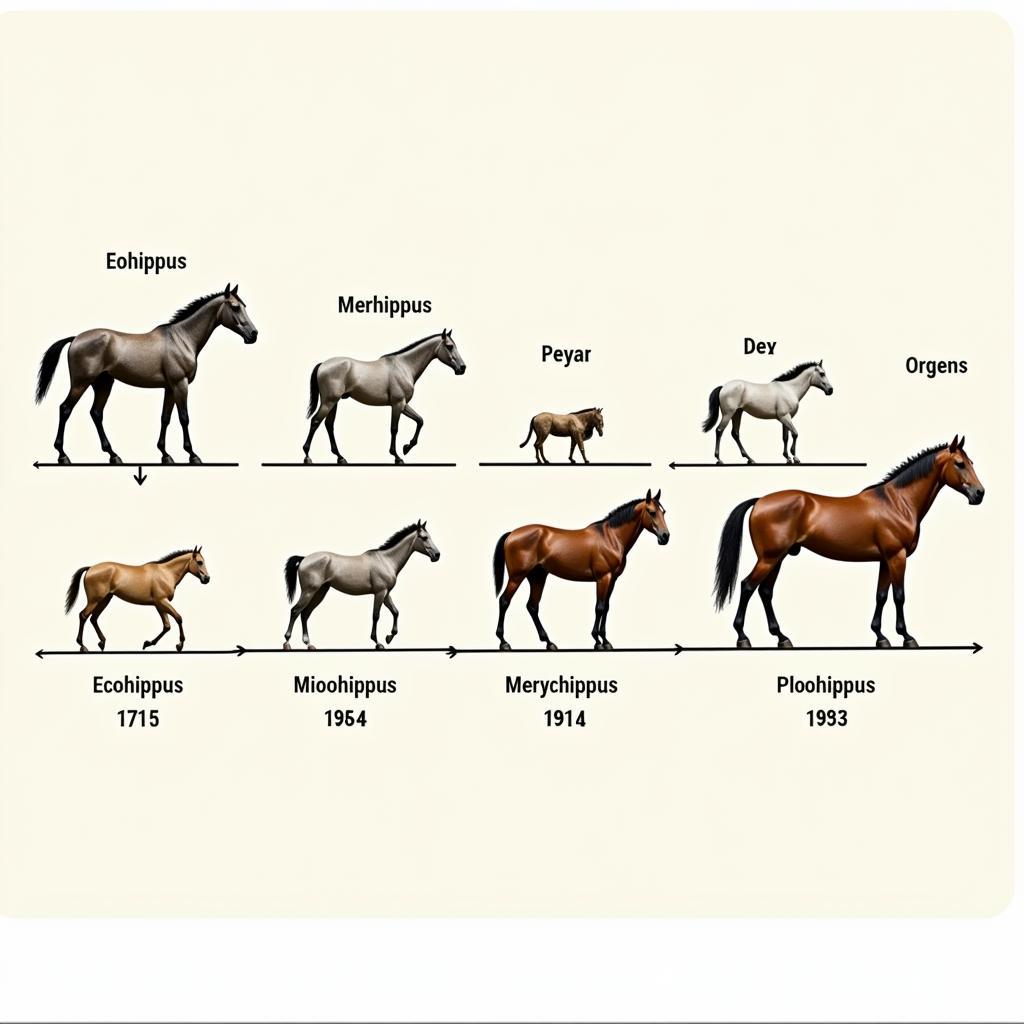The Horse Family Tree, also known as the Equidae family, is a fascinating journey through millions of years of evolution. From the tiny eohippus to the modern-day thoroughbred, the horse’s lineage is a testament to adaptation and survival. This article delves deep into the equine family history, exploring the branches and key players that shaped the horses we know and love today.
Exploring the Ancient Roots of the Equidae Family
The horse’s story begins over 50 million years ago with a small, dog-sized creature called Hyracotherium, commonly known as Eohippus. This ancestor of the modern horse lived in the dense forests of North America and Europe, possessing four toes on its front feet and three on its hind feet, perfectly adapted for navigating the soft forest floor. Over time, environmental changes led to the evolution of Mesohippus, slightly larger and with three toes on all feet.
The evolution continued with Miohippus, adapting to the expanding grasslands with longer legs and stronger teeth for grazing. Merychippus followed, a three-toed horse with a grazing-focused diet, setting the stage for the single-toed horses we know today. Pliohippus is considered the first single-toed horse, a direct ancestor of Equus, the genus that includes modern horses, zebras, and asses.
 Equine Evolution Timeline from Eohippus to Modern Horse
Equine Evolution Timeline from Eohippus to Modern Horse
Understanding the Modern Equus Genus: Zebras, Asses, and Horses
The Equus genus encompasses several species, including horses, zebras, and asses. Each species has unique characteristics, showcasing the diversity within the horse family tree. Horses, characterized by their flowing manes and tails, are further divided into various breeds, each developed for specific purposes. Zebras, with their distinctive stripes, roam the African savannas. Asses, including the domesticated donkey, are known for their hardiness and strength.
Though seemingly different, these animals share a common ancestor, their close relationship evident in their similar skeletal structure and social behaviors.
If you’re interested in horse-drawn carriage rides in Frederick, MD, check out our page.
Delving Deeper into Horse Breeds and Their Lineage
From powerful draft horses like the Clydesdale to the graceful Arabian, the diversity within horse breeds is astounding. Each breed boasts a unique history and lineage, shaped by human intervention and natural selection. Understanding the horse family tree within specific breeds can help owners appreciate the characteristics and traits of their equine companions. For instance, the Thoroughbred’s lineage is meticulously documented, tracing back generations to showcase its racing pedigree.
For details on the Confederation Horse, visit our dedicated page.
What is the Purpose of Studying the Horse Family Tree?
Studying the horse family tree is more than just an academic pursuit. It allows us to:
- Appreciate the evolutionary process: Understanding the horse’s journey provides insights into adaptation and survival.
- Improve breeding practices: Knowledge of lineage helps breeders make informed decisions for desired traits.
- Understand horse behavior: Recognizing the ancestral instincts can aid in training and management.
- Conserve endangered species: Studying the family tree of wild equids can contribute to conservation efforts.
- Connect with equine history: It fosters a deeper appreciation for the horse’s role in human civilization.
Looking for horse carriage rides in Easton? Visit our page for details.
Conclusion: The Horse Family Tree – A Legacy of Evolution
The horse family tree is a captivating narrative of evolution, showcasing the remarkable journey from a small forest dweller to the majestic animals we know today. Understanding this lineage provides invaluable insights into horse breeds, behavior, and the importance of conservation. The horse’s story continues to unfold, and our appreciation for their evolutionary journey enriches our connection with these magnificent creatures. Learn more about the fascinating world of horses by exploring further resources and continuing your exploration of the equine family tree.
FAQ
- What is the earliest known ancestor of the horse? Hyracotherium, also known as Eohippus.
- What is the genus that includes modern horses? Equus.
- What are some other members of the Equus genus? Zebras and asses.
- How has the horse evolved over millions of years? Through adaptations such as changes in size, toe configuration, and teeth structure.
- Why is it important to study the horse family tree? It provides insights into evolution, breeding practices, horse behavior, and conservation efforts.
For information on the Iron Horse Bar & Grill menu, check out our page. Also, explore more about the Harley horse on our dedicated page.
Need help with your horse or pet? Contact us at Phone: 0772127271, Email: [email protected] or visit us at QGM2+WX2, Vị Trung, Vị Thuỷ, Hậu Giang, Việt Nam. We have a 24/7 customer support team.